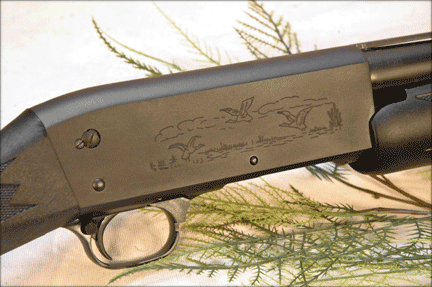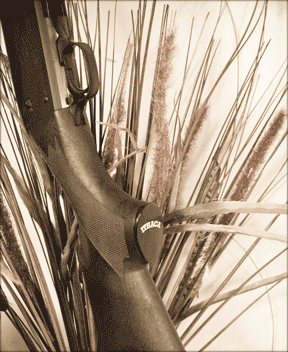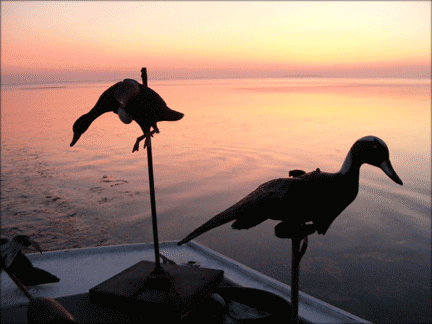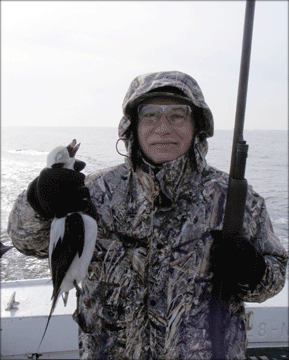New Ithaca Waterfowl 12 Gauge on the Horizon
Starting in March 2010, the Ithaca Gun Company will begin shipment of a waterfowl pump gun that’s infused with a weather and scratch resistant treatment believed to be the second application of this formula for a civilian shotgun – the first coming with
Introduced at the 2010 SHOT Show in

Unlike the more popular Parkerizing dipping process for protecting firearms against corrosion, Perma-Guard is infused into the metal to a depth of 0.0005/0.001 of an inch for an extremely thin and durable bond that does not interfere with the action or other moving parts through distortion or thickness. That means Ithaca was able to apply Perma-Guard on the entire shotgun (except the hammer, springs and firing pins) without compromising performance caused by ill-fitting coated parts.
The matte-black finish on the Ithaca waterfowl 12 gauge that we shot is said to be salt-water-corrosion resistant up to as much as 90 hours. It has a Rockwell hardness rating in the mid-60s – equal to a hardened steel tool.
Ithaca declined to discuss the details of Perma-Guard, but we were given an opportunity to shoot a prototype of the new waterfowl 12 gauge, and we can say unequivocally that it was smooth and accurate on our sea-duck hunt.
Built on the 100-percent, American-made, Ithaca Model 37 Featherlight, the forthcoming waterfowl pump will initially be available in black, with camo to follow. The waterfowl gun resembles Ithaca’s Model 37 Defense gun, except that the waterfowl barrel is 9½ inches longer since it features the standard 28-inch barrel of the Model 37 Featherweight with a fluorescent orange sight on the muzzle.

Like the Ithaca Featherlight, the waterfowl pump gun will weigh 7.1 pounds and hold five rounds.
The waterfowl shotgun benefitted from
The receiver on the waterfowl pump was machined from a single billet. Ithaca refrains from soldering. The company’s Solderless Barrel System (SBS) relies on very tight milling tolerances. The rib slides onto stanchions machined directly into the barrel, and is held in place by a single screw. Having previously shot several Ithaca shotguns, we can report that they shoot very straight with no evident barrel distortion after heavy usage. The shot-pattern integrity remained consistent.
When assembling the waterfowl pump, you lock the barrel into the receiver with a twist versus sliding it straight in like on our Beretta 391 semi-auto. On the Featherlight, a lug slides around to make contact with the end cap, exerting additional pressure on the forend while at the same time acting as a lock washer. With this design you don’t need to continuously tighten the end cap during a day’s worth of hunting as is often the case on other shotguns.
Ithaca’s waterfowl pump uses the Featherlight’s lengthened forcing cones to reduce recoil and shot deformation. While out on the boat that calm, cold morning we were surprised at the minimal felt recoil on the face considering it’s a 12-gauge pump. Ithaca has managed to tame muzzle jump despite loading the 3-inch chambers with Winchester Xpert Hi-Velocity Steel Shot rated at 1,400 fps packed with 1? ounces of #2 shot sent through an improve-modified choke.

Naturally, with all those clothes on we didn’t feel any recoil against our shoulder. That’s where the 14¼ inch length of pull came in handy, allowing us to easily mount the shotgun despite all the layers of thick clothing.
The waterfowl pump will also incorporate the Featherlight trigger with a pull of 4-6 pounds. The trigger pull on our waterfowl shotgun came in at a delightful 3.4 pounds. We would hope that the production run of the waterfowl pump not exceed four pounds of pull since the trigger was really quite nice. It sustained good feel and control through our gloves.
Our prototype featured the bottom loading and ejection port designed into all Ithaca Model 37s. The benefits are clear. It eliminates the typical side ejection port normally exposed to inclement weather while preventing spent hulls from hitting your buddies when hunting in a blind or other close quarters such as boat.
We embarked before dawn from Queen Anne’s County Slips in the Kent Narrows on Maryland’s Eastern Shore on the 40-foot Jo-B-Mar II. It was a Robbins Bay Built Boat, about 30 years old, owned by veteran captain, Tom Quimby.
He navigated through the surface ice, motoring southwest. A blush pink daybreak materialized over tiny Parsons Island as the sun projected over the horizon line with the force and fury of Helios’ blazing shield. A dead calm set apart this January morning, the stretches of unfrozen water taut and still, as though we had never left the port. The easy chug-chug of the boat gave voice to the Ithaca motto “Take an Old Friend Hunting.” While most sea-duck excursions rattle your bones and slap you in the face, we were moving through a dream toward our destination.

Our coffee, mini-donuts and amiable conversation was occasionally interrupted to point out the solo acrobatic long-tail ducks that popped into view, or the expansive formations of blue-bill ducks flying high in the lavender haze.
About an hour later, we started spreading strings of long-tail decoys – their black and white bodies laid out in a semi-circle around the boat.
Long tails, in singles and pairs, rocketed toward the decoys but would turn at the last minute. I took some near-impossible shots to warm up with the
As the ducks continued flying out of range, and then disappeared entirely for long stretches of time, it seemed as though we were caught in some sort of Chesapeake spell. Captain Quimby would raise anchor and move the decoys – still nothing.
Finally, the talk turned to heading back empty-handed. We already had been out some eight hours, and while the weather remained pleasant and the waters calm, ultimately we were capitulating to the restlessness and boredom.
Captain Quimby suggested we move the decoys one last time. He fired up the engine and towed the string for a few minutes before he shut it down, when a long tail swerved toward the starboard side. I’m not sure if the others saw it, since the bird came about from the stern very low and fast. I simply shouldered the Ithaca and when the long tail came within some 30 yards I pulled off a single shot. It went down, bobbing on the surface, head submersed.

I shucked the gun, ready for a second shot, but that was unnecessary.
The sound of the shot caught everyone’s attention and they saw by the smile on my face I had made a clean shot. Captain Quimby started the Jo-B-Mar II as we went to fetch the long tail.
Cheers and congratulations as we saw up close the bird that kept eluding us all day.
Now I would be the last guy to describe myself as a great shot, but at the same time that long tail was not a lucky shot either. The Ithaca came up so easy, and the trigger pull smooth and even, as the lead came reliably into view, it simply was one of those moments where shooter and gun were unbeatable together.
After that shot, we decided to stay out a while longer, but no other shots were made that day.
Imagine – the only guy on the boat to bag a sea duck in that dreamy calm of the Chesapeake Bay.
Irwin Greenstein is the Publisher of Shotgun Life. You can reach him at contact@shotgunlife.com.
Helpful resources:

Irwin Greenstein is Publisher of Shotgun Life. Please send your comments to letters@shotgunlife.com.


Comments